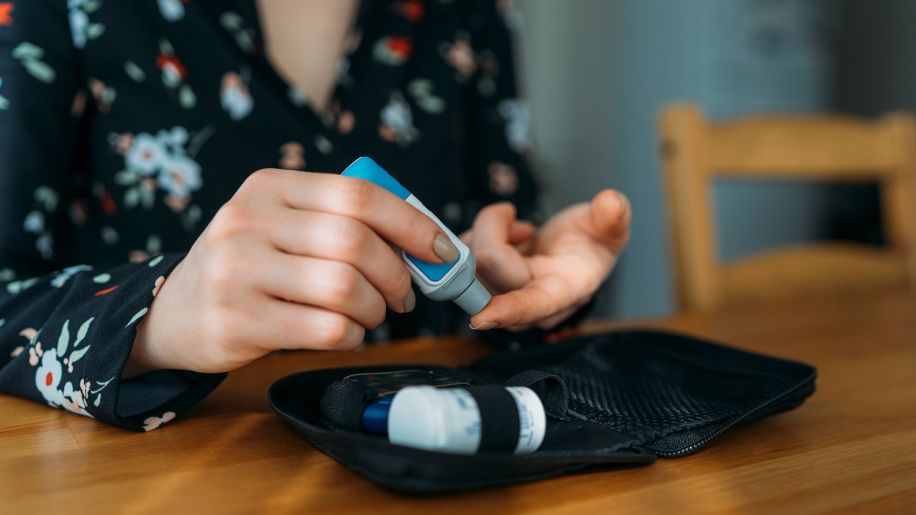Overtime work increases your diabetes risk, says study—plus, 12 other factors
Logging more than 45 weekly work hours can up your odds for this condition.

Are You At Risk for Type 2 Diabetes?
More than 30 million Americans have either Type 1 or Type 2 diabetes, metabolic disorders that result in too much glucose (sugar) in your blood. Another 84 million Americans have prediabetes, a condition that, if left untreated, could lead to type 2 diabetes within 5 years.
Type 1 diabetes, often diagnosed in childhood, is the result of the body failing to produce insulin—it's not something you can prevent. People with the second and most common form of the disease—type 2—cannot use the insulin their body's produce. Anyone can be diagnosed with type 2 diabetes, but it's most common among middle-aged and older adults.
There are some diabetes risks we can't alter, like family history, age and ethnicity. But factors like weight, diet and daily activity can be tweaked to reduce your risk of the condition. Read on for 13 of the biggest diabetes risks, and find out what you can do to decrease your odds.

You work too much
Long hours in the office may boost your pay check and help you earn some appreciation from your boss, but it might also hurt your health. Women who log longer work hours may have an increased risk of developing type 2 diabetes, suggests one study.
Canadian researchers analyzed the medical records of 7,000 men and women between the ages of 35 and 74 during the 12-year study period. Women who clocked 45 or more hours at work each week were at a greater risk of developing diabetes than those who worked 35 to 40 weekly hours. Research showed no significant association between men who work long hours and an increased diabetes risk. Regardless of gender, 1 in every 10 people tracked as part of the study developed diabetes.
The study couldn't prove cause an effect, though it does suggest an association. The link between long work hours and diabetes is somewhat unclear, but researchers believe stress may play a part. Work-related stress can produce hormones that, over time, increase insulin resistance and obesity, which up your diabetes odds.

You're a couch potato
A sedentary lifestyle is one of the biggest diabetes risk factors, and recent studies link too much sitting—at your work desk or on the couch—to an increased chance of developing the disease. Choosing a less sedentary career may not be an option, but regular exercise can help combat the effects of day-long sitting.
Physical activity, in addition to helping you achieve and maintain a healthy body weight, can help move glucose from the bloodstream to your muscles, where it's burned up as energy. This helps keep your blood sugar levels steady.
Regular physical activity also helps prevent other diabetes risk factors, like stress and insomnia, but how much do you need? Government recommendations urge adults to get a weekly minimum of 150 minutes of moderate-intensity of 75 minutes of vigorous-intensity aerobic activity.
It's not as hard as you might think—try taking a walk on your lunch hour, going for a leisurely bike ride after dinner or taking a weekend trip to the local pool for a few laps.

You have belly fat
Skyrocketing diabetes rates are directly linked to America's burgeoning waistlines. More than 85 percent of people with type 2 diabetes are overweight, according to the National Institutes of Health. In addition, over 70 percent of US adults are overweight or obese, according to recent data. Overweight is defined as a body mass index (BMI) between 25 and 30, while obesity is a BMI of 30 or greater.
The link between excess body weight and diabetes is not clear, but experts suspect extra pounds—especially around your midsection—cause the body's cells to resist the hormone insulin, which carries glucose to cells to use as energy. When you develop insulin resistance, cells can't take up the glucose, resulting in high blood sugar levels.
Cleaning up your diet—and eating a mix of fruits, veggies, lean protein and healthy fats—can help you slim down. Regular physical activity, adequate sleep and stress reduction can also result in weight loss.

You haven't had a glucose test
Knowledge is power, which is why regular screenings are so important. A simple blood test can identify a rise in blood glucose and detect prediabetes, a condition characterized by blood sugar levels that are slightly elevated but not high enough to qualify as diabetes.
Prediabetes affects about 84 million Americans. "When people learn they have prediabetes, I tell them they're extremely lucky," says Betul Hatipoglu, MD, an endocrinologist at Cleveland Clinic. "It's an opportunity for them to make changes so they can reverse the disease."
Eating a healthy diet, shedding extra weight, moving more and getting conditions like hypertension and high cholesterol under control can help reverse prediabetes. Your specific risk factors will help determine how often a blood glucose test should be performed, but most people should get screened every one to three years.

You don’t get enough sleep
Too little sleep can impair your memory and alertness, affect your mood and relationships and increase your risk for diseases like hypertension, stroke and diabetes.
When you skimp on sleep, the body secretes extra stress hormones that can lead to insulin resistance and weight gain, Dr. Hatipoglu says. "People who don't sleep enough at night are also hungrier because they have more ghrelin, a hormone that makes you eat more," she says.
Adults should aim for 7 to 9 hours of nightly shuteye. If you think you're getting enough sleep but don't wake up refreshed or your partner says you snore throughout the night, see your doctor. You may have sleep apnea, a sleep disorder that causes breathing to stop repeatedly throughout the night, and can boost your diabetes risk.

You eat a bad diet
For many, a bad diet can boost your diabetes odds. Foods high in unhealthy fat, sugar and calories can lead to weight gain, a risk factor of diabetes. A healthy diet should be rich lean protein, heart-healthy fats, fruits and veggies, which most Americans don't get enough of. Eating too few fruits and vegetables puts you at risk for many health problems, including diabetes. In fact, one survey found that fewer than half of Americans eat five or more servings of fruits and vegetables most days of the week. Per government recommendation, adults should aim to consume between 2 and 3 daily cups of vegetables and 1 ½ to 2 cups of fruit a day.
Of particular benefit are leafy greens: spinach, kale and collard greens. One analysis found eating an additional one and a half serving of leafy greens a day—about 1 ½ cups of raw greens—can lower your diabetes risk.
Adding greens to your meal isn't all that difficult—even if you hate salads. Try blending spinach into your fruit smoothie (you won't even taste it). Fold kale into your morning omelet, chuck a handful of greens into your next pot of soup or wrap sliced veggies and a serving of lean protein into a crisp iceberg or butter lettuce leaf.

You live with stress
Managing a busy to-do list and crazy work hours isn't just stressful, it can also increase your diabetes risk. Chronic stress triggers the release of extra stress hormones, like cortisol, which can lead to insulin resistance and cause blood sugar levels to climb. Stress also contributes to other diabetes risk factors, like depression, a bad diet and poor sleep, Hatipoglu says.
Getting stress levels under control can help lower your risk for these conditions, and techniques are simpler than you might think. Yoga, deep breathing and meditation are proven ways to help quell stress and can be done almost anywhere. Spending time with friends or enjoying a nightly sitcom for some laughter can also help quiet stress.

You guzzle sugary drinks
It's not uncommon to enjoy the occasional soda with Friday night pizza, but drinking too many sugar-sweetened beverages—juices, energy drinks, sweetened ice tea and coffee drinks—can help pack on the pounds and increase your obesity and diabetes risks.
That's not the only connection between diabetes and sugary drinks. Experts suspect sugar-sweetened beverages also alter the body's ability to use insulin efficiently, causing blood sugar levels to rise.
Instead, try serving up a glass of cold water. Or sip a cup of sparkling water, flavored with a squeeze of citrus fruit, like lemon, lime or orange. This beverage offers the fizzy flavor so many enjoy, without the extra calories and sugar.

You have hypertension
More than 100 million US adults are considered hypertensive under the latest American Heart Association guidelines published in November 2017.
High blood pressure, or hypertension, is the state in which your blood pressure levels are higher than normal.
- Normal—systolic less than 120 mm Hg and diastolic less than 80 mm Hg
- Elevated—systolic 120 to 129 mm Hg and diastolic less than 80 mm Hg
- Hypertension stage 1—systolic 130 to 139 or diastolic 80 to 89 mm Hg
- Hypertension stage 2—systolic 140 mm Hg or higher or diastolic 90 mm Hg or higher
- Hypertensive crisis—systolic higher than 180 mm Hg and/or diastolic higher than 120 mm Hg
If you have high blood pressure, your heart is working harder than it should to pump blood throughout your body. Hypertension is often a sign of diabetes, Hatipoglu says. The good news: Many of the same steps that help prevent diabetes, like regular exercising and a healthy diet, can also help lower high blood pressure.

You're depressed
Depression is a mood disorder than can leave you feeling sad, angry, anxious and irritable. It can also cause a loss of interest in activities you once enjoyed. Chronic depression may also up your diabetes risk by 60 percent.
It's not uncommon for people with depression to skip regular exercise and eat an unhealthy diet, both of which can boost your odds of developing diabetes. Depression has also been linked to hormonal changes that can raise your risk for obesity and diabetes, according to some research. If you suspect you're depressed, talk to your doctor about treatment, which may include medication, therapy or a combination. Your mental and physical help will thank you.

You're getting older
As if more wrinkles and gray hair aren't enough, aging can also increase your risk for conditions like diabetes. Although type 2 diabetes can affect people of any age, it's more common among people 45 and older. When your metabolism slows, you start to lose muscle mass and your weight creeps up.
As you add years to your life, maintaining a healthy diet, staying physically active and getting screened per your doctor's recommendations becomes even more important.

Your family has diabetes
It's true that your genes play a role in your diabetes risk. If you have a parent or sibling with diabetes, especially type 2, your odds of developing it are significantly higher. If one twin has type 2 diabetes, the other's risk of developing it can be as high as 3 in 4.
The American Diabetes Association notes that heredity isn't destiny. You may be genetically predisposed to diabetes, but watching your weight and exercising, can delay or even prevent diabetes. If you don't know your family history, ask!

Your race or ethnicity
People of some races or ethnic groups have a higher diabetes risk than the general population. Compared with Caucasians, the type 2 diabetes risk among African Americans, Asian Americans, Hispanics, American Indians and Pacific Islanders can be up to 77 percent higher.
You can't change your race or ethnicity, but knowing your risk can help you better control other diabetes risk factors, like weight, diet, stress and sleep. Speak with your doctor about your specific risks and ask how often you should be tested for diabetes.
Featured Content

article

slideshow
